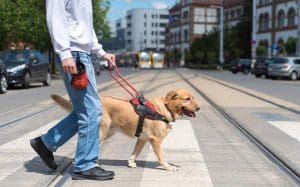
Understanding Service Dog Certification
Before diving into the process of obtaining certification, it’s essential to understand what service dog certification entails. Service dog certification verifies that a dog has undergone rigorous training to perform specific tasks that assist individuals with disabilities. This certification is not a legal requirement, but it serves as an acknowledgment of the dog’s skills and training, providing reassurance to the public and establishments where the service dog and its owner may go.
Identifying the Need for a Service Dog
The decision to pursue a service dog certification typically stems from a genuine need for assistance due to a physical or mental disability. It’s crucial to identify this need and assess whether a service dog could significantly improve the individual’s quality of life. Service dogs are trained to perform a wide range of tasks, including guiding individuals with visual impairments, alerting those with hearing impairments to sounds, providing stability and support for individuals with mobility issues, and even offering emotional support to those with mental health conditions. Evaluating the specific needs and requirements is the first step in the certification process.
Working with a Reputable Training Program
Once the decision to pursue a service dog has been made, the next step is to work with a reputable training program or organization that specializes in training service dogs. These programs employ skilled trainers who are experienced in working with dogs and individuals with disabilities. It’s essential to thoroughly research and select a training program that is accredited and has a proven track record of successfully training service dogs.
Assessing the Dog’s Suitability
Not all dogs are suitable candidates for becoming service dogs. Temperament, behavior, and trainability are crucial factors that determine a dog’s suitability for service work. The selected training program will likely conduct a thorough assessment of the dog to determine its suitability for service dog training. This assessment involves evaluating the dog’s temperament, sociability, willingness to work, and ability to remain calm and focused in various environments.
Undergoing Comprehensive Training
Service dog training is a comprehensive process that typically involves teaching the dog specific tasks tailored to the individual’s needs. Depending on the type of assistance required, the dog may undergo training to perform tasks such as retrieving items, opening doors, providing balance support, or even detecting and responding to medical emergencies. The training program will work closely with the dog and its handler to ensure that the dog masters these tasks and is capable of performing them reliably in real-world situations.
Obtaining Certification and Documentation
Once the training is complete, the dog and its handler will need to obtain certification and documentation to validate the dog’s status as a service animal. This often involves obtaining a certification or identification card from the training program or organization. While these certifications are not legally required, they can be beneficial in situations where the handler needs to provide proof of the dog’s status as a service animal.
Navigating Legal Rights and Responsibilities
It’s important for individuals with service dogs to be aware of their legal rights and responsibilities. In the United States, the Americans with Disabilities Act (ADA) protects the rights of individuals with disabilities who rely on service animals. Understanding these rights, including where service dogs are allowed to accompany their handlers, and the responsibilities of service dog handlers in maintaining control and care of their animals, is crucial for a harmonious and respectful interaction with the public.
Obtaining service dog certification is a significant undertaking that requires careful consideration and commitment. The journey to acquiring a service dog involves collaboration with a reputable training program, thorough assessment of the dog’s suitability, comprehensive training, and understanding of legal rights and responsibilities. For individuals with disabilities, the presence of a well-trained service dog can offer invaluable support and independence, ultimately enhancing their quality of life.






